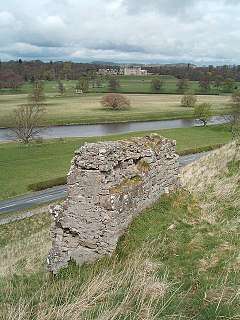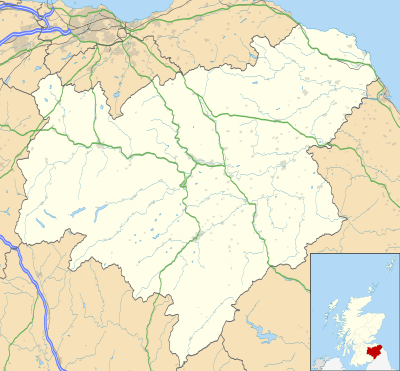Roxburgh
Roxburgh (/ˈrɒksbərə/), also known as Rosbroch, is a civil parish and now-destroyed royal burgh, in the historic county of Roxburghshire in the Scottish Borders, Scotland. It was an important trading burgh in High Medieval to early modern Scotland. In the Middle Ages it had at least as much importance as Edinburgh, Stirling, Perth, or Berwick-upon-Tweed, for a time acting as de facto capital (as royal residence of David I).
Roxburgh
| |
|---|---|
 Roxburgh Castle, River Tweed and Floors Castle | |
 Roxburgh Location within the Scottish Borders | |
| Population | 419 (2001) |
| OS grid reference | NT713337 |
| Civil parish |
|
| Council area | |
| Lieutenancy area | |
| Country | Scotland |
| Sovereign state | United Kingdom |
| Post town | KELSO |
| Postcode district | TD5 |
| Dialling code | 01573 |
| Police | Scotland |
| Fire | Scottish |
| Ambulance | Scottish |
| UK Parliament | |
| Scottish Parliament | |
History
Its significance lay in its position in the centre of some of Lowland Scotland's most agriculturally fertile areas, and its position upon the River Tweed, which allowed river transport of goods via the main seaport of Berwick-upon-Tweed. Its position also acted as a barrier to English invasion.
Standing on a defensible peninsula between the rivers Tweed and Teviot, with Roxburgh Castle guarding the narrow neck of the peninsula, it was a settlement of some importance during the reign of David I who conferred Royal Burgh status upon the town. At its zenith, between the reigns of William the Lion and James II, it was the site of the Royal mint. The town also had three churches and schools which operated under the auspices of the monks of Kelso Abbey. In 1237, the future Alexander III was born there.[1]
English and Scots forces repeatedly captured and recaptured the town during the Scottish Wars of Independence. During his occupation of Scotland, Edward III of England resided at Roxburgh Castle, spending at least two birthdays there. The castle was besieged several times, notably in 1314, in the run-up to Bannockburn. Its final recapture in 1460 saw the town and castle destroyed. After this time the town never regained its importance because the final English capture of Berwick-upon-Tweed in 1482 left Roxburgh with little reason to exist, henceforth lacking a port.
Nothing remains of the town except some ruined segments of castle ramparts. Its site lies to the south of modern Kelso and Floors Castle, which lie on the other side of the Tweed. Roxburgh was superseded as the county town of the former county of Roxburghshire by Jedburgh.
Very little else is known about this hugely important site, in part due to the landowner Duke of Roxburghe's refusal to allow archaeologists to dig here until comparatively recently. The Channel Four television programme Time Team undertook excavation work in 2003, and their findings were broadcast on 21 March, 2004.[2]
Etymology
Roxburgh probably comes from Old English *hrōcas burh, "rook's burgh".[3]
Roxburgh District
 Roxburgh District 1975–96
Roxburgh District 1975–96
In more recent times (1975–1996), "Roxburgh" referred to a local government district in the Borders region of Scotland. Its borders broadly resembled those of the traditional county of Roxburghshire. In 1996 the district of Roxburgh became part of the Scottish Borders unitary area. (See also: Subdivisions of Scotland.)
Roxburgh village
Today the name Roxburgh belongs to a small village about 2 miles (3 kilometres) south-southwest of the site of the historic Roxburgh.
References
Notes
- Groome, Francis H. (1901) Ordnance Gazetteer of Scotland, p. 1408-9
- https://www.wessexarch.co.uk/sites/default/files/52568_Roxburgh.pdf
- roxburgh Family History Facts 1920 – Ancestry.com
Sources
- Sadler, John (2005). Border Fury: England and Scotland at War, 1296–1568. Harlow, England: Pearson/Longman. ISBN 9780582772939. OCLC 55596227.
| Wikimedia Commons has media related to Roxburgh. |
